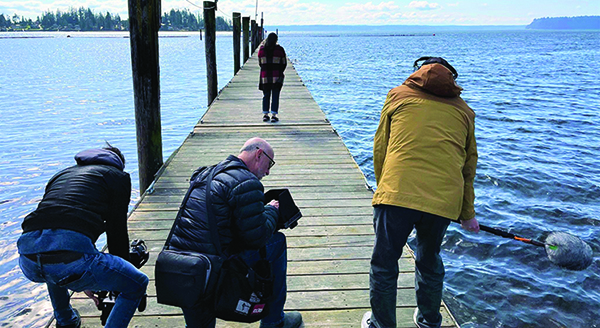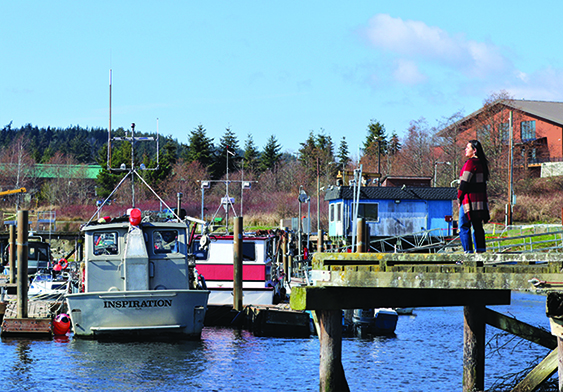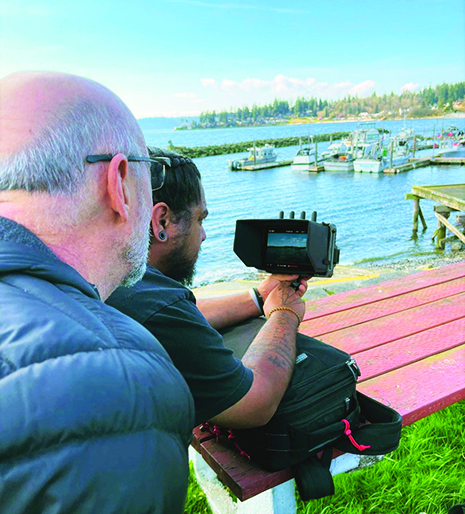
By Micheal Rios, Tulalip News
Recently, an exciting independent TV series showcasing authentic Native American culture and Coast Salish identity ventured to Tulalip to film at the local marina. The undisclosed project underwent a critical rewrite that required a new scene; one in which the always scenic Tulalip Bay and its marina full of fishing boats provided the perfect backdrop for.
“I had been here previously while working with Tulalip tribal member Marjorie James on an iSTEAM project. During that visit we walked from the youth center to the marina and I remember thinking ‘Wow, this reminds me so much of where I grew up in southeast Alaska,’” recalled producer and writer Larisa Koenig (Tlingit/Haida). “So when we were rewriting the end of this season and it felt like the particular place this character would be at is overlooking a marina, I instantly thought of the beautiful views here.
“It’s a priority of ours to honor Native people and Native culture in this project. Part of that is to be intentional about highlighting local Native communities and areas. Where better to shoot a marina scene involving the wife of a fisherman than an active fishing marina on the Tulalip Reservation?” she added.

For decades, Native Americans have been largely absent from the big screen, relegated to stereotypes and sidekick roles in Westerns and other genres. However, in recent years there has been a growing movement within the film industry to tell more authentic and diverse stories from within the Native diaspora. The range of stories, whether told in a modern context or historical, obtainable from the 574 federally recognized tribes can offer an endless supply of creative vision for those behind the camera.
One of the driving forces behind this movement is the increasing visibility and influence of Native American filmmakers, actors, and advocates. From Sterlin Harjo’s (Seminole Nation) FX breakout tv series Reservation Dogs to the Native-centered feature length films Te Ata and Wind River to the upcoming Disney+ superhero crime drama Echo, our voices are finally being heard and celebrated in the mainstream.
But the fight for representation is far from over. According to a 2019 report by the USC Annenberg Inclusion Initiative, Native Americans were the most underrepresented racial/ethnic group in Hollywood, accounting for just 0.4% of all speaking characters in top-grossing films from 2007 to 2018.

That’s why it’s so important for those with studio access capable of reaching the masses to continue to elevate Native American voices and stories. By providing more opportunities for talented Native actors and creatives to tell their own stories on their own terms, film directors and producers can help to challenge and break down the harmful stereotypes and misconceptions that have plagued us from achieving authentic representation for so long.
Which is why it was such a literal breath of fresh air during that picturesque spring afternoon when the TV production filmed actress Amber Cantu (Colville) walking the marina’s familiar wooden docks, while gazing into the heart of Tulalip Bay.
“The idea for this independent film venture began fifteen years ago when my wife and I were raising our nine children, which included five adopted Native siblings. This really is a family project, with our kids heavily involved in the behind the scenes production,” explained Michael Lienau, founder of Global Net Production and tv series director.
His extensive film background includes award winning productions like Healing America’s Wounds – highlighting racial strife and the power of forgiveness with John Dawson; Return of the Raven (PBS) profiling a Native American’s stand against the U.S. Government; and Native Apology Resolution – Congressional briefing video distributed to all members of Congress.
“We are so grateful to the Tulalip Tribes for giving us the opportunity to film here,” said director Lienau. “Many movies and TV series have to create fake sets to replicate real places like this. Being able to film on a real reservation with an active fishing marina while Tulalip fisherman practice their Treaty Rights, we’re beyond thankful for that.”